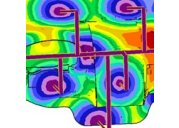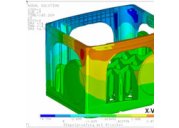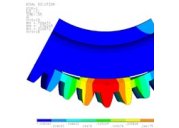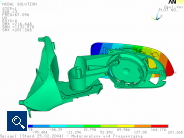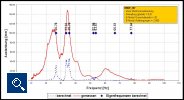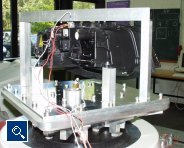Dynamic analysis
Major reduction of the experimental effort and the development period with dynamic simulations
The vibrational behavior of a system is an important criterion for a lot of technical components or entire assemblies within the automotive as well as in the household appliances industry. Suspension movements are transferred from the road to other vehicle components or spinning movements in washing machines are transferred to other appliance parts. Therefore the plastics simulation center calculates as an additional area of specialization complex, dynamic systems in addition to static load tasks. The typical tasks include the analysis of vibration states of a component in the case of different stimuli (module analyses) as well as the simulation of the vibration behavior of entire assemblies. Component and prototype tests are performed to calibrate the calculations, especially during the analysis of entire assemblies in the course of the simulation calculations e.g. rough road track test and vibrators (hydropulsers). The Plastics Simulation Centre works with its customers on their in-house testing facilities or offers access to external vibrator equipment.
Simulation of dynamics
The calculation of the dynamic properties of the components particularly comprises the prediction of the vibration states in the case of various stimuli. Therefore calculated modal analyses were performed that demonstrate at which frequencies the component is induced to vibrate. Following this a road map for optimization can be sketched. Movement sequences of complex mechanisms - also under the influence of force functions, based on springs, mufflers and cams extending to dynamic bend-to-bend contacts can be simulated.
Dynamic behavior of assemblies
Now that the dynamic calculation of individual components has been state of the art for some time the simulation of entire assemblies is now ready for application. Up to now the vibration behavior of assemblies was only inspected once the first pilot production components were available. Necessary component changes with a renewed inspection of the system then caused a major delay of market launch of the products accompanied by substantial expenses. Impetus Plastics Engineering has been going down new paths for years: The experimental expenditure following the production of a model can be greatly reduced for an assembly and the vibration behaviour of similar components can be predicted by simulating the dynamic behavior of an assembly.
Plastics simulation center
- Determination of resonant frequencies (modal analysis)
- Calculation of resonances process whilst taking account of the non-linear component behavior and the muffling (frequency response analysis)
- Calibration of vibration calculation by alignment with the customer
- Dynamic assembly simulation
Examples
- Vibration-control design of front headlights, rear and brake lights
- Implementation of specified resonant frequency, e.g. of wing mirrors and interior mirrors
- Fanwheels under the influence of unbalanced stresses
- Dynamic design of pump rotors and pump bodies
As a specialist for the simulation of injection moulding processes and component stresses Impetus Plastics Engineering has so far demonstrated its expertise in hundreds of projects. The calculation of component variants, FEM simulations of load conditions, deformation situations and failure modes, structural analyses of glass fibre reinforced injection moulded parts as well as anisotropy tests can be found in the service portfolio.
